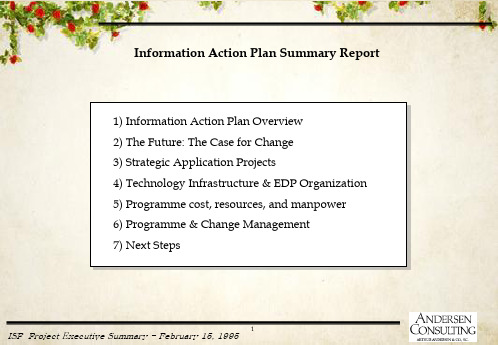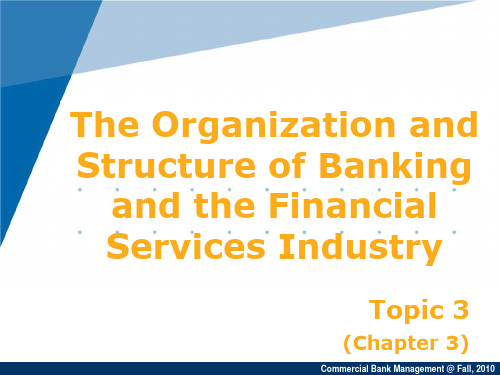UK Retail Banking Creating a Customer-Centric Branch MS_RetailBank_WP_oddpages
- 格式:doc
- 大小:813.00 KB
- 文档页数:16

白皮书:金融服务您的企业正在转型还是在调整21世纪零售银行模式全球银行业的变革21世纪零售银行模式白皮书目录:介绍全球银行业的变革21世纪的银行技术:促成业务战略未来之路客户管理流程企业架构信息支付沟通外包IT/业务一体化结论业务和系统一体化,增强企业竞争力作者简介3456779101111121213141515新世纪的许多重大事件——从全球化和日益增多的并购,到法规变化和技术突破——都使得银行将其注意力转移到效率与客户关系拓展上来。
在21世纪的第一个十年中,银行将如何调整以适应一个飞速变化的景象呢毕博携手Datamonitor公司,一起访问了全球领先零售银行中的技术高层,探知各家银行如何运营转型来迎接新世纪,并阐述他们在新世纪竞争激烈的环境中取得成功的理念。
该全球研究报告揭示了全球银行业在未来5至10年中的发展方向。
这些行业领先者的意见为我们描述了21世纪银行的愿景,以及如何利用IT来实现愿景。
介绍各个银行必须寻找持续增长的方式,并且同时转型成为拥有大批超越传统银行的专业人才及资源的高效率管理的组织。
这种效率的竞争将使金融机构中的数据经纪人比银行家还多。
那些具备世界级数据存贮、管理及分析能力的组织,将能够凭借快速开发和引进下一代产品,使自己独树一帜。
这种从银行家向数据经纪人的转型正在降低传统的准入壁垒,为新的参与者打开银行业的大门。
目睹了沃尔马最近在美国三个州及加拿大为进入银行业务所做的尝试,表面上是为了降低成本而处理借贷及电子支票业务。
银行业对沃尔马这种举动的不断抵制清楚地表明,银行对于非传统竞争对手进入市场这一全新潮流的担忧。
其二,金融交易,作为银行的传统核心业务,正在快速地日常商品化。
展望未来,银行必须将其业务视作锁定客户、服务客户及维护客户关系的一个整体。
更深入地了解客户,这对于保留现有客户和实现收入增长来说必不可少。
最后,法规要求是史无前例。
为满足不同地区严格的合规性标准,银行需要透明的系统和流程,同时需要建立更加有效的、预测性的更强的方法来进行信息的收集、存贮和处理。



欧陆银行中英文对照版-最完整版本(已收到offer)Structure组织结构Umbrella organization:伞式组织:It supports the Board of Director in managing the entire bank.该组织为董事会管理整个银?提供?持。
Some members of the umbrella organization are simultaneously(同时地) members of the Board of Directors.伞式组织的部分成员同时也是董事会成员。
Joseph Fieldman is one of the members of the Board of Directors.约瑟夫·费曼是董事会成员之?。
Subordinated(次级的) to umbrella organization are three divisions:伞式组织属下有三?分部Investment Bank(IB):投资银?部:Clients are normally private and public institutions as well as medium-sized and global or national companies.客户通常是私?机构、公共机构、中型公司、国际公司或国内公司。
Every client has its own contact person.每个客户都有??的联系?。
IB offers capital market products on a worldwide basis.投资银?部在全球各地提供资本市场产品。
Private and business clients(PBC):私?和企业客户部:This division is the biggest and most important one of Euro-bank and services private clients and small businesses in investments.这是欧陆银?最?、最重要的业务部门之?。

参考案例苏格兰皇家银行市场细分案例苏格兰皇家银行(Royal Bank 0f Scotland)是英国银行业的“四大家”之一。
该机构在如何获取客户的数据,并最有效地利用这些数据方面可谓功力深厚。
早在几年前,他们就做了大规模的客户调查,在此基础上开展了以价值为中心的客户关系活动。
在这个活动中,客户关系主要通过银行的服务和销售人员简单的手机通话或当面沟通方式建立。
对于一个有330万顾客的银行来说,要维系这样一个大规模的活动显然是劳民伤财。
经过进一步的研究与分析,皇家银行发现很难把他们的顾客按照一般人口统计标准清晰地划分。
因此,银行决定放弃一对一的接触方式,而是根据顾客的个人爱好对其进行分组。
当然,以爱好为依据只是分组的方式之一,其他的分组依据还包括地域、价值等级等。
银行的市场运营部主管Ian Wilson说:“我们认为客户可以按某个指标来分组,但是任何时候一位客户可能同属于几个组。
”苏格兰皇家银行为提高顾客忠诚度不惜动用大量人力,加上其在客户细分方面的深入探索,都为其进一步的创新打下了扎实的基础。
他们随后采用了一套软件解决方案,帮助市场人员能够提供个性化、多渠道的产品给个人客户。
有了这个系统,一些事件驱动(Event—Driven)行动就可以自动执行。
首先,系统会在典型顾客群体身上测试创新产品和方案的效果,如果达到了指定效果,银行会在48小时之内将材料打印并寄送给相关客户。
三四年前,他们每次举办活动都要给30万个客户寄送材料。
现在,平均打印量为2万份。
事件触发式促销活动中,一份群发的邮件名单上只有四五个顾客,而且内容还能反映出顾客的个人特征。
Wilson发现,这些高效和及时的活动取得了75,的客户回复率,而这是以前从未达到过的。
他说:“我们正努力使自己业务由传统的产品主导转变为客户主导。
”便装美人和忙碌而心情平和的成熟女性。
C(品牌传播概念:专为女性设计、表现东方女性的自然之美。
客户产品分析:润妍洗护发系列包括洗发露和润发露,洗护分开,使秀发得到真正滋润。

Bank Customer Manager Responsibilities(English Version)1. Building and Maintaining Customer RelationshipsAs a bank customer manager, your primary responsibilityis to build and maintain strong relationships with clients. This involves understanding their financial needs, providing personalized banking solutions, and ensuring theirsatisfaction with the bank's services.2. Financial Consultation and Advice3. Sales and Business DevelopmentDrive the sales of banking products and services to meet or exceed targets. Identify new business opportunities and develop strategies to acquire and retain highvalue clients. Collaborate with other departments to crosssell and upsell banking products.4. Customer Service and Support5. Risk Management6. Market Analysis and Reporting7. Team Collaboration and Leadership8. Compliance and Ethical Standards9. Professional Development10. Communication and NetworkingBank Customer Manager Responsibilities (English Version)11. Strategic PlanningDevelop and implement strategic plans to grow the customer base and enhance the bank's market presence. This involves setting realistic targets, creating action plans, and monitoring progress to achieve longterm business objectives.12. Portfolio ManagementOversee the management of client portfolios, ensuring they are aligned with the bank's investment strategies and client objectives. Regularly review and rebalance portfolios to optimize performance and minimize risks.13. Credit Analysis14. Relationship DeepeningEngage in relationship deepening activities to strengthen ties with existing clients. This may include organizingclient events, providing exclusive financial insights, and offering personalized services.15. Technology AdoptionStay abreast of financial technology trends and champion the adoption of digital banking solutions to enhance customer experience and operational efficiency. Encourage clients to utilize online and mobile banking services.16. Training and CoachingProvide training and coaching to junior staff members, ensuring they have the necessary skills and knowledge to deliver exceptional customer service and contribute to the bank's success.17. Performance MonitoringRegularly monitor and evaluate the performance of the team against set goals and objectives. Provide constructive feedback and implement performance improvement plans when necessary.18. Crisis ManagementHandle emergency situations and crises effectively, ensuring minimal disruption to client services and maintaining the bank's reputation. Develop and implement contingency plans to address potential risks.19. Community Engagement20. Feedback and Continuous ImprovementActively seek and incorporate client feedback to improve banking products, services, and processes. Champion a culture of continuous improvement within the team and the organization.By embodying these responsibilities, a bank customer manager not only contributes to the financial success of the institution but also builds trust and loyalty among clients, fostering a strong and lasting relationship.Bank Customer Manager Responsibilities (English Version)21. Regulatory Compliance Oversight22. Financial EducationEducate clients on financial literacy and the importance of budgeting, saving, and investing. Organize workshops or seminars to empower clients with the knowledge to make informed financial decisions.23. CrossCultural Communication24. Referral Program Management25. Market ResearchConduct market research to identify emerging trends and customer needs. Use this insights to propose new products or services that could enhance the bank's offerings.26. Event Coordination27. Change ManagementLead and support the bank through periods of change, such as the implementation of new systems or processes, ensuring a smooth transition for both staff and clients.28. Conflict ResolutionAddress and resolve any conflicts that may arise between clients and the bank, or within the team, in a fair and timely manner to maintain a harmonious working environment.29. Performance ReportingPrepare detailed performance reports for senior management, highlighting key performance indicators, market trends, and areas for potential growth or concern.30. Professional ConductUphold the highest standards of professional conduct and integrity, serving as a role model for colleagues and embodying the bank's core values in all interactions.As a bank customer manager, your role is multifaceted, requiring a blend of financial expertise, interpersonal skills, and strategic thinking. By fulfilling these responsibilities with dedication and professionalism, you not only drive the bank's success but also play a pivotal role in helping clients achieve their financial aspirations.。
客户体验:领先银行的成功之道 改善客户体验已日益成为全球领先企业CEO的核心要务。在四大因素的共同驱使下,客户体验成为了未来银行业竞争的焦点: 最近三年,麦肯锡就客户体验的议题实地考察了20多家全球领先银行及硅谷的金融科技创新公司。其中包括:欧洲荷兰ING银行,英国苏格兰皇家银行(RBS),西班牙对外银行(BBVA ),英国汇丰银行(HSBC),澳大利亚联邦银行(C o m m o n w e a l t hBank of Australia)和西太平洋银行Westpac),北美的第一资本(Capital One),摩根大通(JPMorgan),富国银行(Wells Fargo),花旗银行(Citi Bank)等领先银行。 除此之外,麦肯锡还考察了迪士尼、用户体验管理平台的独角兽公司Medallia、欧洲最早的互联网银行mBank、葡萄牙千禧(Millennium)集团专攻年轻市场的ActivoBank、意大利地中海投资银行集团委托设计公司打造的全新概念分行CheBanca等企业。 这些成熟市场的经验表明,并购、产能提升和网点布局优化等传统手段已难维系商业银行进一步的显著增长,先进银行的CEO不约而同地将眼光转向了提升客户体验,以此换取可观的投资回报:10-15%的营收增长,15-20%的服务成本降低,20-30%的员工满意度提升。 基于考察结果,麦肯锡总结出了国际领先银行打造卓越客户体验的六大战略举措: 英国生物学家、进化论的奠基人查尔斯·达尔文曾提出:“能够生存下来的物种不是最强的,也不是最聪明的,而是最适应变化的”。以客户为中心进行组织变革是银行能否打造卓越客户体验的分水岭。麦肯锡认为,未来能生存的银行是最注重客户、了解其需求、并不断提升客户体验的银行。为此,银行需要针对客户体验进行三大变革:全渠道战略变革、敏捷组织架构变革、“以客户为中心”的组织文化变革。 因地制宜地打造卓越的客户体验,中国银行业需要做好五大环节:
What next in retail banking? By Jeremy Bryson, Director Financial Services, Atos Consulting Summary As never before, the environment for retail banking is transforming due to pressures from customers, shareholder sand regulators. Banking are responding across the board to these demands not with the silver bullet type projects but through managing the detail. This is most felt around the new discipline of customer, channel and product interaction (CCPI) management. This more than anything else will drive success in the medium to long term.
Introduction Banking around the World has undergone changes in the last 10 years that are greater than the previous 30. Banks are fitter, more flexible and more responsive to their customers. They are also generally more profitable and better able to manage the risk that is pivotal to their business.
UK Retail Banking: Creating a Customer-Centric Branch
Microsoft UK Published: June 2003
Abstract This white paper provides an overview of research based on interviews with UK retail banks at the end of 2002. The paper discusses the need to co-ordinate areas of investment in customer-centric bank systems around a service-oriented architecture, rich technology support for customer-facing staff and improvement of the customer‘s interaction with the bank‘s processes. Only by combining these elements will the customer‘s overall experience of the branch, and the bank, improve. UK Retail Banking: Creating a Customer-Centric Branch, Microsoft UK, June 2003 2
The information contained in this document represents the current view of Microsoft Corporation on the issues discussed as of the date of publication. Because Microsoft must respond to changing market conditions, it should not be interpreted to be a commitment on the part of Microsoft, and Microsoft cannot guarantee the accuracy of any information presented after the date of publication.
This document is for informational purposes only. MICROSOFT MAKES NO WARRANTIES, EXPRESS OR IMPLIED, AS TO THE INFORMATION IN THIS DOCUMENT.
Microsoft may have patents, patent applications, trademarks, copyrights, or other intellectual property rights covering subject matter in this document. Except as expressly provided in any written license agreement from Microsoft, the furnishing of this document does not give you any license to these patents, trademarks, copyrights, or other intellectual property. © 2003 Microsoft Corporation. All rights reserved.
Acknowledgements A number of Microsoft partners have been instrumental in creating this paper, and we would like to pass on our thanks to: AIT Group Allen-International Ltd DPR Consulting Financial Objects plc Fincentric Corporation NCR Unisys UK Retail Banking: Creating a Customer-Centric Branch, Microsoft UK, June 2003 3
Overview The resurgence of the branch and its re-acceptance as a major customer channel for retail banking means that all of the major high street banks are currently considering or developing strategies to revitalise their branch assets.
In the past, change has focused on the interests of the bank, rather than the customer. But customers are maturing and their relationships with, and perceptions of, the high street bank are changing. The majority now see through advertising, and are judging institutions, both new and old, on the quality of their service. For banks to retain their existing customers, increase footfall in their branches, effectively cross-sell and attract new customers, they need to address customer needs and create a customer-centric experience. No matter how much time and money is spent on other channels, a poor branch experience can taint an otherwise satisfied customer‘s view of the brand, leaving them more open to competitors‘ marketing.
Re-defining the branch and its role in the channel mix is key to maximising its value to both the bank and its customers. But upgrading the branch must go further than purely cosmetic changes; there is a need to embrace a change in service and attitudes. Staff must be freed from spending the majority of their time carrying out administrative duties and given more time to talk to and build relationships with account holders.
Over the past decade, the banking world has undergone a drastic change in its structure and practices. As banks have turned to technology in an effort to reduce staffing levels and shave costs, customers have been pushed away from traditional banking channels such as the branch towards using external ATMs, the Internet and interactive voice response systems. For cost saving purposes, banks would like their customers to confine all but the most complex of tasks to these channels.
But in general, it is clear that retail customers are still reliant on interaction with bank staff. This is proven by customers being willing to queue for a period of time either in the branch or on the phone to get personal service. The next generation of branch and multi-channel systems now available provide banks with an opportunity to encourage customers to use low-cost channels for low-value servicing and transaction requests, so that bank staff are free for sales duties. By employing the latest customer relationship management (CRM) technology, banks can help their customer-facing staff within the branch to become more effective sales advisors – trusted, or at least tolerated, by the customer.